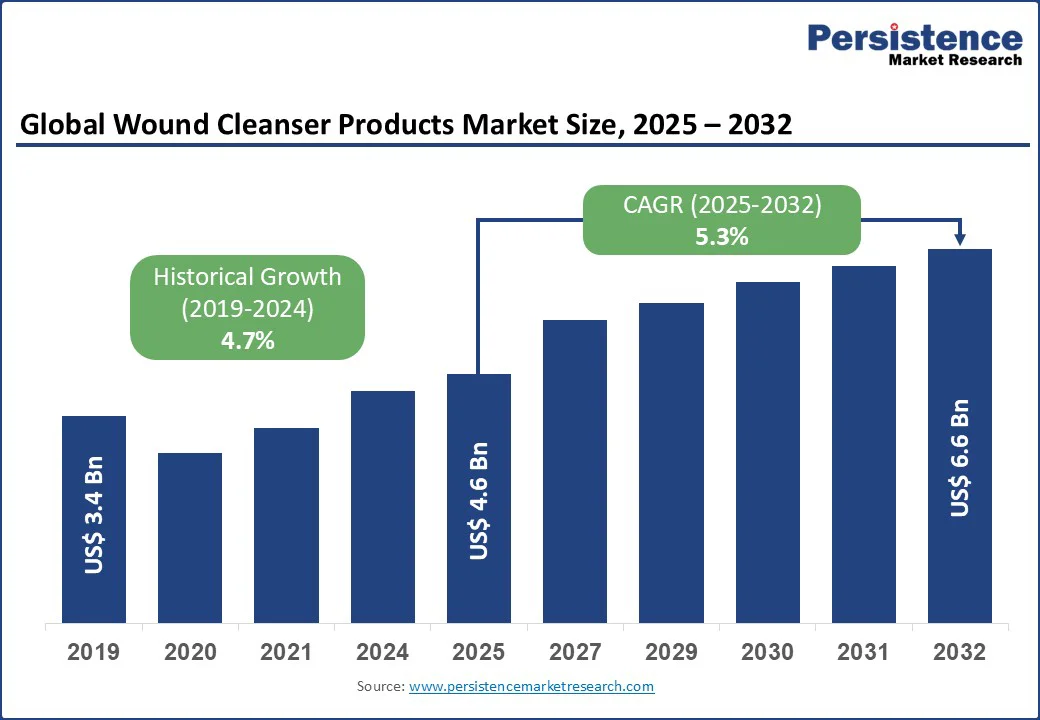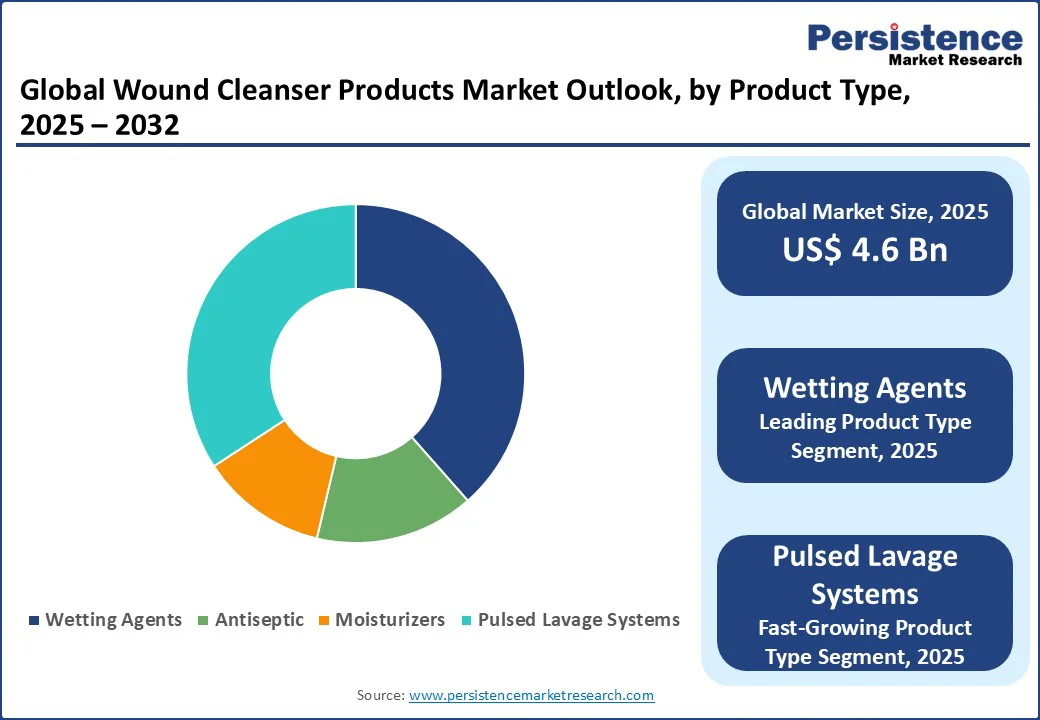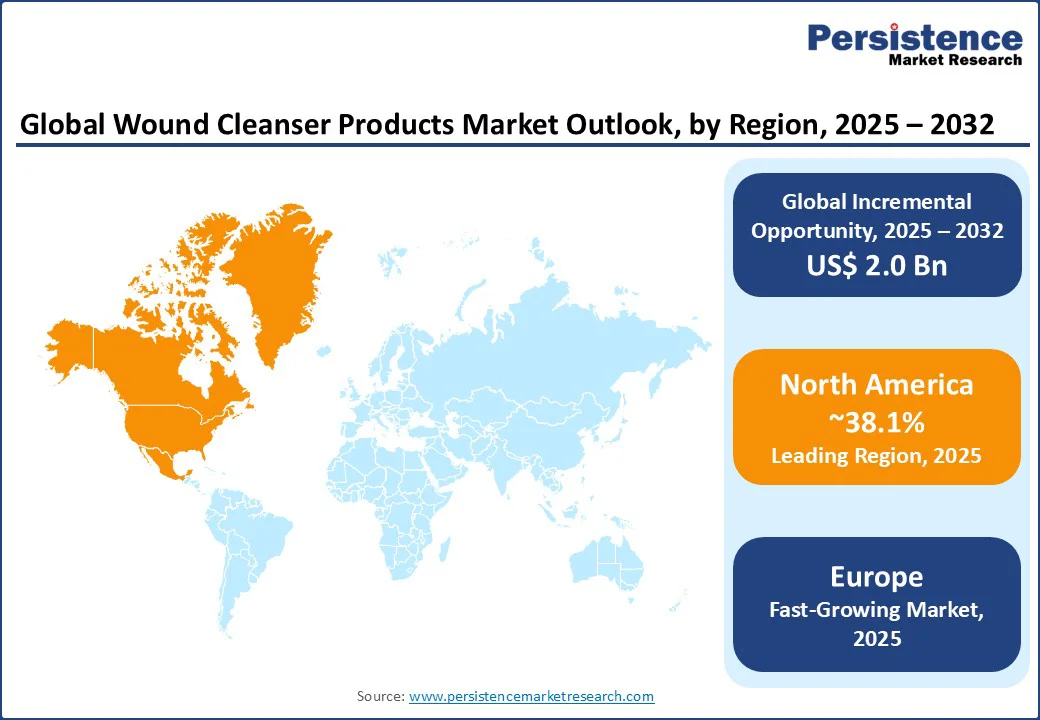ID: PMRREP11689| 199 Pages | 22 Sep 2025 | Format: PDF, Excel, PPT* | Healthcare

The wound cleanser products market size is likely to be valued at US$ 4.6 Bn in 2025 and is estimated to reach US$ 6.6 Bn in 2032, growing at a CAGR of 5.3% during the forecast period 2025-2032, fueled by rising chronic health conditions, increasing surgical procedures, and surging awareness of infection prevention.
Key Industry Highlights:

| Key Insights | Details |
|---|---|
|
Wound Cleanser Products Market Size (2025E) |
US$ 4.6 Bn |
|
Market Value Forecast (2032F) |
US$ 6.6 Bn |
|
Projected Growth (CAGR 2025 to 2032) |
5.3% |
|
Historical Market Growth (CAGR 2019 to 2024) |
4.7% |
The increasing prevalence of chronic health conditions, including diabetes, obesity, vascular disorders, and autoimmune diseases, is augmenting demand for wound cleanser products. Patients with these conditions are more susceptible to slow-healing wounds and complications such as ulcers and infections, creating a consistent demand for effective wound care solutions.
Advanced wound cleansers that combine antimicrobial properties with gentle debridement help manage such complex wounds while preventing infection. For example, products such as 3M’s Tegaderm Wound Cleanser are specifically designed for diabetic foot ulcers, showing how chronic health trends are directly shaping product adoption and market growth in North America and Europe.
The steady increase in surgeries, from orthopedic procedures to emergency trauma interventions, is boosting demand for wound cleanser products. Surgical wounds and trauma-related injuries require prompt and thorough cleansing to reduce the risk of infection and facilitate quick healing.
Modern solutions such as pulsed lavage systems with suction are being adopted in hospitals and clinics due to their efficiency in removing debris and bacteria. For instance, Sonoma Pharmaceuticals’ intraoperative irrigation systems in the EU showcase how technological developments are being applied to meet the rising surgical and trauma care requirements.
The rising incidence of wound infections is another key factor fueling the wound cleanser products market. Infections, especially those caused by antibiotic-resistant bacteria, can severely delay healing and increase hospitalization. As a result, healthcare providers are turning to novel wound cleansers that incorporate antimicrobial agents and biocompatible formulations.
Hypochlorous acid-based solutions, including Vashe and Granudacyn, are gaining traction for their proven efficacy in reducing microbial load and preventing biofilm formation. This trend reflects the urgent requirement for safe and highly effective infection control in both hospital and home care environments.
One of the key restraints is the potential cytotoxicity of some formulations. Certain antiseptic or chemical-based cleansers, while effective in eliminating microbes, can also damage healthy skin and underlying tissue. This dual effect limits their use in sensitive or chronic wounds, where maintaining cell viability is important. For example, traditional iodine- or alcohol-based solutions can impair fibroblast and keratinocyte function, which are essential for tissue repair. Therefore, healthcare providers are cautious in selecting products, preferring gentler alternatives such as hypochlorous acid-based solutions that balance antimicrobial activity with cellular safety. Such safety concerns tend to slow the adoption of harsh cleansing solutions in hospitals and home care settings.
Wound cleansers that interfere with normal cellular processes can unintentionally delay healing, posing a major market restraint. Overly harsh formulations tend to disrupt fibroblast proliferation, angiogenesis, or epithelialization, which are key stages of tissue repair. This is critical in chronic wounds, where cellular function is already compromised.
For instance, research has shown that high concentrations of certain antiseptics can lead to slow epithelial migration, prolonging recovery times. Consequently, clinicians prefer formulations that optimize microbial control while supporting tissue regeneration such as enzyme-based or biocompatible cleansers. However, the requirement for such careful selection can constrain the widespread adoption of low-cost alternatives.
The integration of smart technologies in wound care presents a new opportunity for wound cleanser products. Sensors and connected devices can monitor wound conditions such as moisture, pH, and temperature, allowing real-time assessment of healing progress. These technologies enable personalized cleansing regimens and targeted therapy delivery.
For example, companies are developing smart dressings that can release cleansing agents or antimicrobials in response to infection markers. Start-ups in Europe and North America are pioneering this approach, combining wound cleansers with digital monitoring platforms, which not only optimize healing but also reduce hospital visits and healthcare costs.
The use of novel antimicrobial agents in wound cleansers is creating substantial opportunities in the market. Agents such as hypochlorous acid and polyhexanide deliver effective infection control while minimizing cytotoxicity to healthy tissue. These compounds are valuable in managing chronic and surgical wounds prone to biofilm formation.
Vashe and Granudacyn have gained recognition for their antimicrobial efficacy without compromising cell viability, making them preferred choices in hospital and home care settings. As multidrug-resistant infections continue to rise globally, the adoption of such novel antimicrobial wound cleansers is expected to accelerate.
Biofilms and persistent inflammation are leading barriers to wound healing, creating an opportunity for specialized wound cleansers. Products designed to disrupt biofilms while controlling inflammatory responses can help improve healing rates, mainly in chronic wounds. Enzyme-based cleansers and novel irrigation solutions are being developed to break down biofilm structures and remove necrotic tissue.
Recent developments in Europe and Asia Pacific involve formulations that blend biofilm-targeting agents with antimicrobial activity, improving both efficacy and patient comfort. This dual-action approach positions wound cleansers as a key component in advanced wound care protocols, delivering superior growth potential in hospital and home healthcare markets.
Wetting agents are predicted to account for approximately 38.5% of share in 2025. These are essential in wound care due to their ability to reduce surface tension, improving the spread and penetration of cleansing solutions. This property facilitates the removal of debris and bacteria from wound surfaces, promoting a clean environment conducive to healing. Their inclusion in wound cleansers ensures effective debridement, especially in chronic or infected wounds, by dispersing contaminants and reducing the risk of infection.
Pulsed lavage systems are projected to see steady growth because of their efficiency in cleaning wounds and surgical sites. The pulsatile irrigation combined with suction effectively removes debris, bacteria, and necrotic tissue, which is important in preventing infections and promoting healing. These systems are beneficial in orthopedic surgeries and chronic wound management, delivering a less painful alternative to traditional methods.
Solutions are poised to hold nearly 32.1% of share in 2025. These are favored for their versatility and effectiveness in managing various wound types. They can be customized with antimicrobial agents to address specific infections. This helps in ensuring broad-spectrum microbial control without promoting bacterial resistance.
Wipes are expected to exhibit a considerable CAGR through 2032 owing to their convenience and portability, making them ideal for home care settings and emergency kits. They deliver a hygienic approach to wound management by removing dirt, debris, and bacteria effectively. However, it is important to ensure that wipes are labeled as 'sterile' to prevent potential infections.
Acute wounds are speculated to account for around 63.9% of share in 2025. This is due to their relatively straightforward treatment requirements and the critical importance of preventing infection early in the healing process. These wounds, resulting from trauma, surgery, or burns, require prompt cleansing to remove contaminants and reduce infection risk.
Chronic wounds are likely to surge steadily in the foreseeable future as they are prevalent among aging populations and individuals with conditions such as diabetes and vascular diseases. These wounds often become infected and require specialized care, thereby propelling demand for unique cleansing solutions.

In 2025, North America will likely record a share of about 38.1%. This is attributed to an aging population and a high prevalence of chronic conditions such as diabetes and obesity. According to the Centers for Disease Control and Prevention (CDC), in 2021, around 38.4 Mn individuals of all ages or 11.6% of the U.S. population had diabetes. Technological developments are significantly influencing the market landscape.
The effectiveness of wound cleanser products has been improved by innovations in their formulations such as the addition of enzymes and antimicrobial agents for effective debridement. Additionally, environmentally friendly wound cleansers that follow sustainable practices have improved the market outlook. Leading manufacturers such as 3M and Medline provide products such as the 3M Tegaderm Wound Cleanser and Medline Remedy Phytoplex Skin & Wound Cleanser, contributing to the market's growth.
Europe’s market is being spurred by an increasing focusing on specialized solutions for chronic and complex wounds such as diabetic foot ulcers and pressure injuries. Companies, including Smith & Nephew and Molnlycke, are investing in enzyme-based and antimicrobial cleansers that accelerate healing and reduce infection risks. Recent developments include partnerships between biotech firms and hospitals to test next-generation wound irrigation systems.
These include pulse lavage devices with integrated sensors for monitoring wound exudate. Germany and France are emerging as innovation hubs, with start-ups introducing eco-friendly and biodegradable cleansers, targeting both hospital and home care settings. Regulatory support under the EU Medical Device Regulation (MDR) is further encouraging manufacturers to improve product safety and effectiveness.
Asia Pacific is being driven by increasing prevalence of chronic diseases, rising surgical procedures, and expanding healthcare infrastructure. China, India, and Japan are at the forefront of this growth. Developments in wound cleanser products are emerging, focusing on improving therapeutic outcomes.
For instance, researchers have developed a photodynamic, UV-curable, and fiber-forming polyvinyl alcohol derivative that delivers broad processability and staining-free antibacterial capabilities, addressing challenges in chronic wound infection control. The market is also witnessing a shift toward unique wound care solutions. Active wound care products such as synthetic skin grafts and collagen dressings are gaining traction due to their effectiveness in treating chronic wounds.

The wound cleanser products market is evolving with a mix of established medical device companies and emerging innovators. Key players such as Coloplast and Convatec are expanding their portfolios through acquisitions and new product developments. However, regulatory approvals and reimbursement policies such as those from the U.K.'s NHS are important factors influencing market entry and investment decisions. Emerging companies are introducing novel solutions to address unmet requirements in wound care.
Market leaders in the field of wound cleanser products focus on development, introducing novel antimicrobial and irrigation solutions, while pursuing expansion through acquisitions and global distribution. Key differentiators include clinically proven efficacy, regulatory compliance, and specialized formulations for chronic wounds. Emerging trends include subscription-based supply models and digital-enabled wound care services for remote monitoring.
The wound cleanser products market is likely to value at US$ 4.6 Bn in 2025.
Rising prevalence of chronic diseases and increasing surgical procedures are the key market drivers.
The wound cleanser products market is poised to witness a CAGR of 5.3% from 2025 to 2032.
Development of biofilm-targeting cleansers and integration with digital monitoring platforms are the key market opportunities.
Stryker, Smith + Nephew, and Coloplast Corp. are a few key market players.
| Report Attribute | Details |
|---|---|
|
Historical Data/Actuals |
2019 - 2024 |
|
Forecast Period |
2025 - 2032 |
|
Market Analysis |
Value: US$ Bn/Mn, Volume: As Applicable |
|
Geographical Coverage |
|
|
Segmental Coverage |
|
|
Competitive Analysis |
|
|
Report Highlights |
|
By Product Type
By Form
By Application
By End Use
By Region
Delivery Timelines
For more information on this report and its delivery timelines please get in touch with our sales team.
About Author